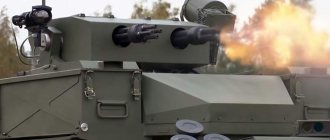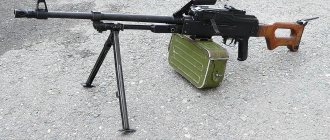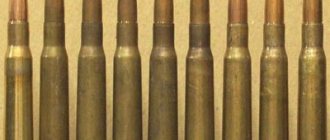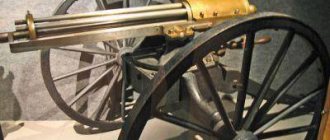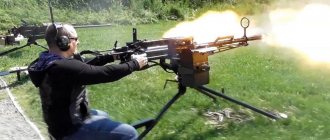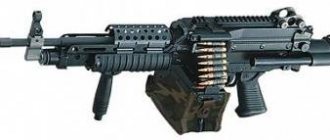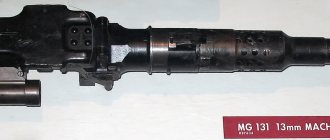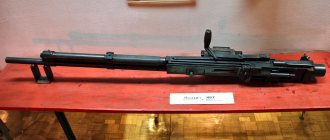| M134 Minigun | |
| Type: | Multi-barreled machine gun |
| A country: | USA USA |
| Service history | |
| Years of operation: | 1963 - present |
| Adopted: | 1960 |
| In service: | see Operators |
| Wars and conflicts: | Vietnam War, etc. |
| Production history | |
| Constructor: | General Electric |
| Designed by: | 1960 |
| Manufacturer: | General Electric, Dillon Aero INC, DeGroat Tactical Armaments, Garwood Industries |
| Years of production: | 1960–present |
| Characteristics | |
| Weight, kg: | 30 |
| Length, mm: | 801 |
| Barrel length, mm: | 558,8 |
| Cartridge: | 7.62×51mm NATO |
| Caliber, mm: | 7,62 |
| Work principles: | electric drive with a power of 1.5 kW |
| Rate of fire, rounds/min: | 3000-6000 |
| Initial bullet speed, m/s: | 869 |
| Sighting range, m: | 500 |
| Maximum range, m: | 300 (effective) 1500 (lethal) 3000 (bullet flight) |
| Type of ammunition: | split-link machine gun belt |
| Images on Wikimedia Commons: | M134 Minigun |
M134 MinigunM134 Minigun
M134 "Minigun"
(eng.
M134 Minigun
) - the name of a family of multi-barreled rapid-fire machine guns built according to the Gatling scheme. The designation in the US Army is M134.
In connection with the introduction of helicopters into service with the US Army, in the 60s there arose a need for light but fast-firing weapons. The new aircraft machine gun, designated M134, was produced by General Electric. It was first used during the Vietnam War and showed its effectiveness.
Design
The rotation drive of the barrel block is electric. The rate of fire is controlled by the electric drive rheostat and varies from 3000 to 6000 rounds per minute. Installation weight - 22.7 kg excluding ammunition systems.
The ammunition used is 7.62 NATO cartridge. The cartridges can be fed from a standard loose belt or using a linkless cartridge feeding mechanism. In the first case, a special “delinker” mechanism is installed on the machine gun, which removes cartridges from the belt before feeding them into the machine gun. The tape is fed to the machine gun through a special metal flexible hose from boxes with a typical capacity of 1500 (total weight 58 kg) to 4500 (total weight 134 kg) rounds. On heavy helicopters (CH-53, CH-47), the capacity of the cartridge boxes to power one machine gun can reach 10,000 or even more rounds.
The cartridge is sent into the lower, cooled barrel, the shot is fired from above, and the cartridge case is ejected from the right. It is used in overhead containers of aircraft, turret mounts of transport and combat helicopters, and in side mounts of Ganship aircraft. The M61 Vulcan aircraft cannon also belongs to this type, where, when firing, the barrels first begin to rotate electrically, and then fire is fired. This principle was created because of the rate of fire, because at such a rate of supply of cartridges (80-100 per second), for each subsequent one a different barrel is needed (usually there are 6 of them).
Operators
| : Incorrect or missing image | This section is missing references to information sources. Information must be verifiable, otherwise it may be questioned and deleted. You may edit this article to include links to authoritative sources. This mark is set February 10, 2014 . |
K:Wikipedia:Articles without sources (type: not specified)
- Australia Australia
- Brazil Brazil
- Canada Canada
- Chile Chile
- Colombia Colombia
- France France
- Georgia Georgia
- Iraq Iraq
- Israel Israel
- Italy Italy
- Mexico Mexico
- Netherlands Netherlands
- USA USA
- UK UK
Principle of operation
The M134 Minigun machine gun, described above, is aimed at the defense of stationary structures. As an offensive weapon, this modification was absolutely unsuitable. With a mass of 30 kilograms and an ammunition supply of 4.5 thousand rounds, no more than a minute was spent in battle until it was completely discharged.
The operation of the unit can be described as follows:
- the automation operates from an external drive mechanism with a DC electric motor;
- the design includes three gears and a worm drive;
- block of six barrels;
- The charge-discharge cycle is divided into several stages, which appear at the junction of the receiver unit and the box.
Impact on culture
In "Predator "
, 1987) the minigun is used by actor Jesse Ventura, the future governor of Minnesota (there is a typo in the source: “Michigan”).
As military historian Gordon L
[1], the use of a minigun as a portable weapon is impossible for several reasons, including weight (78 kg, including the necessary batteries) and recoil (67 kgf on average, 135 kgf peak). The minigun was used as a portable machine gun in the films Terminator 2: Judgment Day, The Expendables 3, Fast and Furious 7, The Purge 2 by James DeMonaco, as well as in the computer games Fallout and GTA.
Equipment
The Minigun M134 machine gun has the ability to mount diopter, collimator and other sighting devices that are needed when using tracer ammunition. In this case, the trace after the shot turns out to be bright and visible, similar to a stream of fire.
It should be noted that the M134 was never shown on a movie screen in real life. This is due to the fact that the strongest recoil and loud sound can knock a person off his feet and put him into a stupor. For the filming of cult films, analogues of the XM214 type (caliber - 5.4 mm) were used, the recoil of which was within the nominal value of about 100 kg. Paradoxically, the second version was in no way suitable for the army, due to its small dimensions and low rate of fire. But for “cinema” Hollywood it was ideal.
Links
Rifles and machine guns M1 and Mark 2 • M1918 • • M14 • M15 • M16 • XM22/E1 • XM106 • XM70 • FN SCAR • HK416/M27 Carbines M1/M2 • XM177/E1/E2 and GAU-5/A • Colt Model 653 • M231 • M4/A1/E2 • GUU-5/P • Mark 18 Sniper rifles M14SE • M21 • M24 • M25 • M39 • M40 • M82 and M107 • M88 and Mark 15 • M110 • Mark 11 • Mark 12 • Mark 14 • DMR • RC-50 • SAM-R • SDM-R • M2010 Submachine guns Thompson • • Smith & Wesson M76 • MP5/K Guns Ithaca M37 • Remington 870 • Mossberg 500/590 • M1014 • XM26 Machine guns M60 series and Mark 43 • XM207/E1 and Mark 23 • M73/M219 • M85 • M240 • Stoner 63 • M249 series and Mark 46 • XM262 • XM312 • Mk 21 • EX 27 • Mark 48 • Browning M2 • GAU-19 • M134 Minigun • LW50MG • LWMMG Hand grenade launchers M79 • XM148 • M203 • M234 • M320 • M32 • EX 41 • Mark 13 Automatic grenade launchers M75/M129 • XM174 • Mark 19 • Mark 47 • XM109 • XM307 Other weapons XM25 • M20A1/A1B1 • M67 • M72 series • M136 (AT4) • M141 • M202/A1 • Mark 153 • FIM-43 Redeye • FIM-92 Stinger • FGM-172 SRAW • Ammo 7.62x33mm • 5.56x45mm NATO • 7.62x51mm NATO • .30-06 Springfield • 12.7x99mm NATO • .300 Winchester Magnum • 9x19mm Parabellum • .45 ACP • 12 gauge This is a draft article about a machine gun. You can help the project by adding to it. : Incorrect or missing image To improve this article it is desirable: - Correct the article according to Wikipedia stylistic rules.
- Find and arrange in the form of footnotes links to independent authoritative sources that confirm what is written. K: Wikipedia: Articles without sources (type: not specified)
- After adding footnotes, provide more precise indications of sources.
see also
| Manufacturer: | General Electric, Dillon Aero INC, DeGroat Tactical Armaments, Garwood Industries |
| Years of production: | 1960–present |
| Characteristics | |
| Weight, kg: | 30 |
| Length, mm: | 801 |
| Barrel length, mm: | 558,8 |
| Cartridge: | 7.62×51mm NATO |
| Caliber, mm: | 7,62 |
| Work principles : | electric drive with a power of 1.5 kW |
| Rate of fire, rounds/min: | 3000-6000 |
| Initial bullet speed, m/s: | 869 |
| Sighting range, m: | 500 |
| Maximum range, m: | 300 (effective) 1500 (lethal) 3000 (bullet flight) |
| Type of ammunition: | split-link machine gun belt |
| Images on Wikimedia Commons: | M134 Minigun |
- XM214 Microgun is a minigun variant chambered for 5.56x45.
- GShG is a Soviet four-barreled analogue.
Excerpt describing the M134 Minigun
- How do they tell fortunes in the barn? – asked Sonya. - Well, at least now, they’ll go to the barn and listen. What will you hear: hammering, knocking - bad, but pouring bread - this is good; otherwise it happens... - Mom, tell me what happened to you in the barn? Pelageya Danilovna smiled. “Oh, well, I forgot…” she said. - You won’t go, will you? - No, I'll go; Pepageya Danilovna, let me in, I’ll go,” said Sonya. - Well, if you're not afraid. - Luiza Ivanovna, may I? – asked Sonya. Whether they were playing ring, string or ruble, or talking, as now, Nikolai did not leave Sonya and looked at her with completely new eyes. It seemed to him that today, only for the first time, thanks to that corky mustache, he fully recognized her. Sonya really was cheerful, lively and beautiful that evening, like Nikolai had never seen her before. “So that’s what she is, and I’m a fool!” he thought, looking at her sparkling eyes and her happy, enthusiastic smile, making dimples on her cheeks from under her mustache, a smile that he had never seen before. “I’m not afraid of anything,” said Sonya. - Can I do it now? - She stood up. They told Sonya where the barn was, how she could stand silently and listen, and they gave her a fur coat. She threw it over her head and looked at Nikolai. “What a beauty this girl is!” he thought. “And what have I been thinking about so far!” Sonya went out into the corridor to go to the barn. Nikolai hurriedly went to the front porch, saying that he was hot. Indeed, the house was stuffy from the crowded people. It was the same motionless cold outside, the same month, only it was even lighter. The light was so strong and there were so many stars on the snow that I didn’t want to look at the sky, and the real stars were invisible. In the sky it was black and boring, on earth it was fun. “I’m a fool, a fool! What have you been waiting for so far? thought Nikolai and, running onto the porch, he walked around the corner of the house along the path that led to the back porch. He knew that Sonya would come here. Halfway along the road there were stacked fathoms of firewood, there was snow on them, and a shadow fell from them; through them and from their sides, intertwining, the shadows of old bare linden trees fell onto the snow and the path. The path led to the barn. The chopped wall of the barn and the roof, covered with snow, as if carved from some kind of precious stone, glittered in the monthly light. A tree cracked in the garden, and again everything was completely silent. The chest seemed to breathe not air, but some kind of eternally youthful strength and joy. Feet clattered on the steps from the girls' porch, there was a loud creaking sound on the last one, which was covered in snow, and the voice of an old girl said: “Straight, straight, along the path, young lady.” Just don't look back. “I’m not afraid,” answered Sonya’s voice, and Sonya’s legs squealed and whistled in her thin shoes along the path towards Nikolai. Sonya walked wrapped in a fur coat. She was already two steps away when she saw him; She also saw him not as she knew him and as she had always been a little afraid. He was in a woman's dress with tangled hair and a happy and new smile for Sonya. Sonya quickly ran up to him. “Completely different, and still the same,” thought Nikolai, looking at her face, all illuminated by moonlight. He put his hands under the fur coat that covered her head, hugged her, pressed her to him and kissed her on the lips, above which there was a mustache and from which there was a smell of burnt cork. Sonya kissed him in the very center of his lips and, extending her small hands, took his cheeks on both sides. “Sonya!... Nicolas!...” they just said. They ran to the barn and returned each from their own porch. When everyone drove back from Pelageya Danilovna, Natasha, who always saw and noticed everything, arranged the accommodation in such a way that Luiza Ivanovna and she sat in the sleigh with Dimmler, and Sonya sat with Nikolai and the girls. Nikolai, no longer overtaking, rode smoothly on the way back, and still peering at Sonya in this strange moonlight, looking for in this ever-changing light, from under his eyebrows and mustache, that former and present Sonya, with whom he had decided never again to be separated. He peered, and when he recognized the same and the other and remembered, hearing that smell of cork, mixed with the feeling of a kiss, he deeply inhaled the frosty air and, looking at the receding earth and the brilliant sky, he felt himself again in a magical kingdom. - Sonya, are you okay? – he asked occasionally. “Yes,” answered Sonya. - And you ?
Development and creation
The M134 Minigun machine gun was originally developed by the American company GE back in 1960. Its caliber was calculated at 7.62 millimeters. The weapon being created is based on an M61 Vulcan type aircraft cannon. This model was built for the air force, combined with the capabilities of the Gatling gun. The first prototypes of the 7.62 mm caliber appeared in 1962. Within two years, weapons began to be mounted on AC-74 aircraft. This solution made it possible to ensure perpendicular firing along the course of the aircraft. This design performed well in support of North Vietnamese infantry, firing from fuselage windows and doors at ground targets.
Considering the success of the tests in theory and practice, General Electric Corporation began their mass production. These models entered service under the designations M134 and GAU-124. In the early 70s of the last century, the US Army numbered over ten thousand copies of the M134 Miniguns. Most of them were mounted on helicopters stationed in Vietnam. Other versions were installed on river vessels transporting special forces.
History of creation
The original idea for the development of this weapon was planned from the middle of the last century. At the same time, the creators wanted to introduce into the design the highest possible indicators of power, rate of fire and aiming. All copies were built at leading factories specializing in the processing of metal and firearms structures. As a result, a unique device appeared, designed for firing from cover or purposefully.
Initially it was planned to produce the unit with a caliber of 12.5 millimeters. However, a power of over 500 kgf at a speed of 6 thousand salvoes per minute brought the idea to a dead end. The updated Minigun machine gun was tested in action on the AC-74 fire support aircraft, aimed at supporting infantry from the air. Experts liked the gun so much that after a few months they began to mount it on aircraft such as the UH-1 and AH-1 Cobra.
Peculiarities
The ability to adjust the firing mode of a multi-barreled machine gun made it possible to install this model on coaxial mounts. In this case, firing at the target was completed by showering its remains with spent lead. This unit terrified the North Vietnamese rebels, who simply fled in panic after shelling forests and ambushes. By the 1970s alone, over 10 thousand copies had been created, which were mainly used to equip transport and attack helicopters. In addition, light watercraft and boats were equipped with such devices.
Some of the weapons in question were installed on wheeled transport vehicles. However, if the battery broke down, the Minigun M134 machine gun worked for no more than 2-3 minutes. A few years later, the civilian version sold well across American states, especially in Texas. The product was operated using infantry bipods with a reserve of one thousand rounds of ammunition. For the gun to operate correctly, a constant power source was required. The supply of cartridges was carried out by wiring a standard tape by sending charges without using links. In the first version, a mechanism for removing cartridges with a special flexible metal sleeve is mounted on the gun.
Exploitation
Moving up and in a circle, the barrel simultaneously removes and ejects the spent cartridge case. The barrel is locked by turning the combat cylinder along with moving the bolts. The last elements are controlled by a groove of a curved configuration. Power is supplied by a linkless supply of charges or by a belt mechanism.
The required rate of fire is guaranteed by a specialized electronic unit, which is equipped with a rate of fire switch and an activation button located on the handle of the gun. The modern variation of the machine gun in question has two firing versions: 2 and 4 thousand salvos per minute. In working condition, there is no kickback of the barrel or movement to the side. Loading of the cartridge is carried out using a special mechanism, which is responsible for the reliability and uninterrupted sending of charges from the very beginning of firing.
